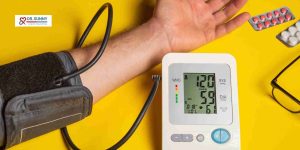The COVID-19 pandemic has left a lasting impact not just through acute illness but also through a growing number of long COVID cases — where symptoms persist for weeks, months, or even years after the initial infection. One condition increasingly recognized among long COVID patients is Postural Orthostatic Tachycardia Syndrome (POTS), a form of autonomic dysfunction that can significantly impact daily life.
If you’ve recovered from COVID-19 but now experience dizziness, a racing heartbeat when standing, extreme fatigue, or brain fog, it’s important to know that these symptoms may not be “just stress” or “normal recovery.” You could be dealing with post-viral POTS — and early treatment can make a real difference.
For residents of Milton, Brampton, and Mississauga, cardiologist Dr. Sunny Malhotra offers specialized evaluation and treatment for POTS, including cases linked to long COVID.
How is POTS Linked to Long COVID?
POTS is a disorder of the autonomic nervous system — the part of your body that automatically regulates heart rate, blood pressure, and blood flow. In healthy individuals, standing up triggers small, precise adjustments to keep blood circulating to the brain. But in POTS, this regulation falters, and your heart rate spikes abnormally.
In recent research, doctors have found that COVID-19 can trigger POTS in some people. Here’s why:
- Post-viral autonomic dysfunction – Viral infections can cause inflammation and damage to the nerves that help control circulation.
- Immune system changes – COVID-19 may set off autoimmune responses, where the immune system mistakenly attacks healthy tissue.
- Persistent inflammation – Ongoing inflammatory processes can disrupt cardiovascular regulation.
This means that weeks or even months after your COVID-19 infection, you may begin experiencing symptoms of POTS — sometimes without realizing the connection.
What Makes POTS After COVID Different?
While POTS symptoms are similar whether caused by COVID or other triggers, post-COVID POTS often appears alongside other lingering symptoms of long COVID, such as:
- Chronic fatigue
- Shortness of breath
- Muscle aches
- Sleep disturbances
One distinguishing factor is that POTS symptoms are triggered or worsened by standing and typically improve when lying down. Patients may also show higher levels of inflammatory and immune-related markers in blood work.
Some people develop POTS shortly after their COVID infection, while others notice it only after gradually resuming daily activities — and realizing they can’t tolerate standing or walking for long without feeling lightheaded or unwell.
Common Symptoms of POTS After COVID
If you’ve had COVID-19, be aware of these symptoms:
- Dizziness or lightheadedness when standing up
- Rapid heart rate (palpitations)
- Extreme fatigue that worsens after physical or mental effort
- Brain fog — difficulty focusing or remembering information
- Exercise intolerance
- Nausea or gastrointestinal upset
These symptoms can range from mildly inconvenient to life-altering, making it essential to seek a proper diagnosis.
How Can Treatment Help?
While there is currently no one-size-fits-all cure for POTS, early and targeted management can significantly improve symptoms and help you regain independence.
A treatment plan may include:
- Hydration strategies – Drinking 2–3 liters of water daily and using electrolyte solutions.
- Increased salt intake – If recommended by your doctor, this can help the body retain fluids and support blood pressure.
- Compression garments – Wearing waist-high compression stockings to prevent blood pooling in the legs.
- Graded exercise therapy – Starting with recumbent exercises like rowing or cycling, then slowly building up to upright activities.
- Medications – Such as beta-blockers, fludrocortisone, or midodrine to help regulate heart rate and circulation.
The goal is to stabilize your symptoms so you can gradually return to normal activities without constant setbacks.
Can a Cardiologist Help Me Recover from POTS After COVID?
Yes. Because POTS involves significant changes in heart rate and blood flow regulation, a cardiologist is well-equipped to confirm the diagnosis and manage treatment.
Dr. Sunny Malhotra provides:
- Comprehensive diagnostic testing – Including tilt-table testing, active stand testing, and autonomic function assessments.
- Ruling out other heart conditions – To ensure your symptoms aren’t caused by structural heart disease, arrhythmias, or other cardiovascular issues.
- Personalized recovery plans – Combining lifestyle guidance, medication, and rehabilitation strategies.
- Ongoing follow-up – Adjusting your care as symptoms change and progress.
This approach ensures that you receive not only symptom relief but also long-term strategies to maintain stability and avoid relapses.
Why Early Diagnosis Matters
If you suspect you have POTS after COVID-19, don’t wait. Delaying care can make symptoms worse and extend recovery time. The sooner you are evaluated, the sooner a treatment plan can be started — improving your chances of returning to work, school, or daily routines.
Many patients find that with a combination of hydration strategies, medical support, and lifestyle adjustments, they can gradually rebuild their stamina and cognitive clarity.
Take Control of Your Recovery
POTS after COVID-19 is real, but it’s also manageable with the right support. If you live in Milton, Brampton, or Mississauga and are experiencing dizziness, a rapid heartbeat, fatigue, or brain fog weeks after COVID, you don’t have to face it alone.
Visit www.drsunnymalhotra.com to request an appointment and begin a personalized recovery plan with Dr. Sunny Malhotra — an experienced cardiologist who understands both the cardiovascular and autonomic aspects of POTS.



